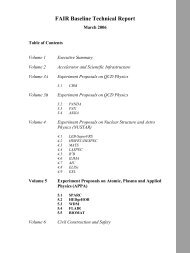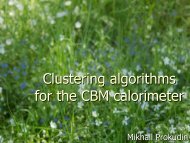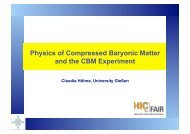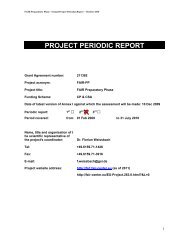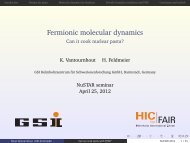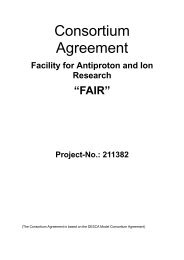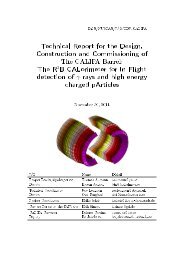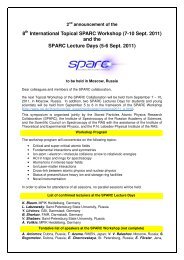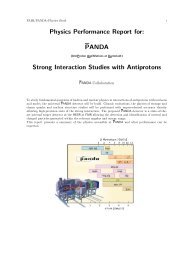NeuLAND - FAIR
NeuLAND - FAIR
NeuLAND - FAIR
Create successful ePaper yourself
Turn your PDF publications into a flip-book with our unique Google optimized e-Paper software.
We observe a very high percentage of proper neutron recognition, i.e. the neutron<br />
number is correctly derived from the algorithm, indicated in bold in the tables. Even<br />
for the lowest neutron energies the 4-neutron recognition still stays close to 50%, for<br />
the highest beam energies values of more than 60% are obtained. In this example the<br />
calorimetric cuts were set in manner favouring too low neutron multiplicities over too<br />
high ones. So, more events are erroneously assigned to a lower neutron multiplicity than<br />
to a higher neutron multiplicity. The separation matrices derived in this simulation,<br />
explore a combined efficiency, taking both the neutron tracking capabilities and the<br />
geometrical acceptance into account. <strong>NeuLAND</strong> is located in the full-acceptance distance<br />
for the relative energy example of Erel = 500 keV discussed here. However, a certain<br />
fraction of neutrons does not reach the detector volume, due to scattering in the air along<br />
their flight path from the target to the detector at a distance of 15.5 m. Exemplarily,<br />
for 600 MeV neutrons approximately 1.5% of the neutrons undergo such an interaction.<br />
For events with a neutron multiplicity of four, in approximately 6% of the events at least<br />
one neutron will not arrive at the detector volume. These losses are contributing to the<br />
values derived in the separation matrices.<br />
The high values for correct multiplicities for 3 and 4 neutron cases are of extreme importance<br />
for the envisaged physics programme with <strong>NeuLAND</strong>, since the investigation<br />
of more and more neutron-rich nuclei is accompanied by higher neutron multiplicities.<br />
The detector depth of 3 m plays a major role for the multi-neutron recognition, since<br />
the calorimetric properties depend significantly on the detector volume. Exemplarily, we<br />
study the one- to five-neutron recognition of a detector, same as <strong>NeuLAND</strong>, but with<br />
a reduced depth of 2 m only. The neutron separation matrix for 600 MeV neutrons is<br />
shown in table 4.6.<br />
detected<br />
600 MeV, 2m depth<br />
generated<br />
% 1n 2n 3n 4n 5n<br />
1n 83 30 7 1 0<br />
2n 7 63 45 17 5<br />
3n 0 5 39 36 18<br />
4n 0 0 8 42 54<br />
5n 0 0 0 3 22<br />
6n 0 0 0 0 2<br />
Table 4.6.: Neutron separation matrix for 600 MeV neutrons, as in the middle panel of<br />
table 4.5, but for a reduced depth of <strong>NeuLAND</strong>, i.e. 2 m instead of 3 m.<br />
While the one-neutron recognition is affected mildly, decreasing from 92% (3 m) to 83%<br />
(2 m), the impact on the multi-neutron recognition is more drastic. For the detector<br />
depth of 2 m, four-neutron events are detected with the correct multiplicity in 42%<br />
of all cases, which is a decrease by 26% compared to the 57% detected with the 3 m<br />
depth of <strong>NeuLAND</strong>. Correspondingly the fraction of misidentified neutron multiplicities<br />
is enlarged.<br />
58





